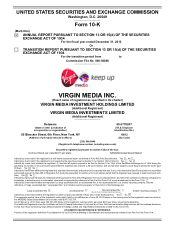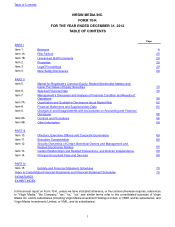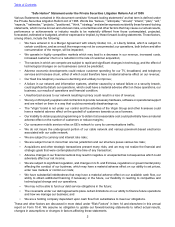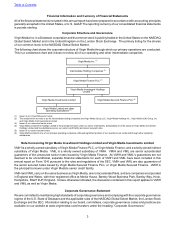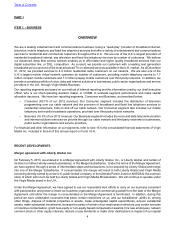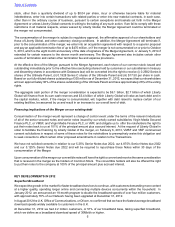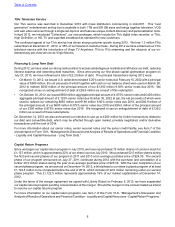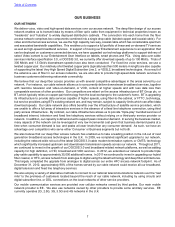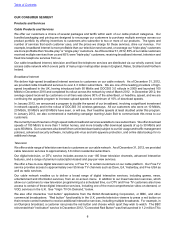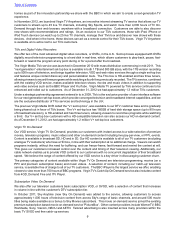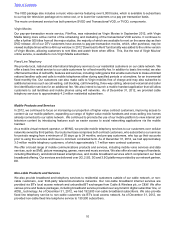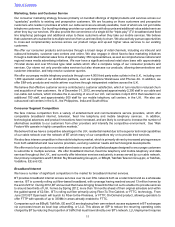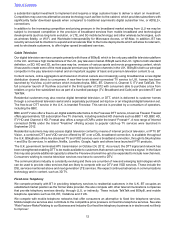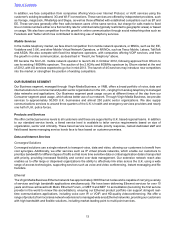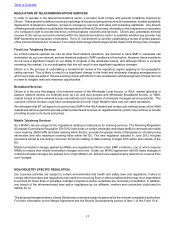Virgin Media 2012 Annual Report Download - page 8
Download and view the complete annual report
Please find page 8 of the 2012 Virgin Media annual report below. You can navigate through the pages in the report by either clicking on the pages listed below, or by using the keyword search tool below to find specific information within the annual report.
7
OUR BUSINESS
OUR NETWORK
We deliver voice, video and high-speed data services over our access network. The deep fiber design of our access
network enables us to transmit data by means of fiber optic cable from equipment in technical properties known as
“headends” and “hubsites” to widely deployed distribution cabinets. The connection into each home from the fiber
access network comprises two components combined into a single drop cable (twisted copper and coaxial cable). For
video and internet access services, we use the high capacity, two-way, coaxial cable which has considerable spectrum
and associated bandwidth capabilities. This enables us to support a full portfolio of linear and on-demand TV services
as well as high-speed broadband services. In support of moving our Entertainment experience to an application that
can be deployed on customers connected devices, we have upgraded our technology platforms to support delivery of
select Video content to our Entertainment User Interface on tablets, smart phones and PCs. Using data over cable
services interface specification 3.0, or DOCSIS 3.0, we currently offer download speeds of up to 100 Mbit/s. Trials of
300 Mbit/s and 1.5 Gbit/s downstream speeds have also been conducted. For fixed line voice services, we use a
twisted copper-pair. Our relatively short twisted copper pairs (typically less than 500 meters in length) are also capable
of supporting the latest Very High Speed Digital Subscriber Line 2, or VDSL2, broadband technologies. As a result of
the extensive use of fiber in our access networks, we are also able to provide high-speed data network services to
business customers delivering nationwide connectivity.
We believe that our deep fiber access provides us with several competitive advantages in the areas served by our
network. For instance, our cable network allows us to concurrently deliver downstream broadband services, together
with real-time television and video-on-demand, or VOD, content at higher speeds and with less data loss than
comparable services of other providers. Our competitors are reliant on the access infrastructure of BT Group plc, or
BT, which typically relies on copper-pair technology from the local exchange to the customer's home. BT is upgrading
its infrastructure to provide data services capable of higher speeds, using fiber-to-the-cabinet, or FTTC, technology,
but service providers using BT's existing network are, and may remain, subject to capacity limits which can affect data
download speeds. Our cable network also offers benefits over the infrastructure of satellite service providers, which
are unable to offer a full array of interactive services in the absence of a fixed line telephone connection, using third
party access infrastructure. By contrast, our cable infrastructure allows us to provide “triple-play” bundled services of
broadband internet, television and fixed line telephony services without relying on a third-party service provider or
network. In addition, our capacity is dimensioned to support peak consumer demand. In serving the business market,
many aspects of the network can be leveraged at very low incremental cost given that business demand peaks at a
time when consumer demand is low, and peaks at lower levels than any consumer demand. As such, we have an
advantage over competitors who serve either Consumer or Business segments but not both.
We also believe that our deep fiber access network has enabled us to take a leading position in the roll-out of next
generation broadband access technologies in the U.K. In 2009, we completed significant upgrades to our network,
including the network-wide roll-out of the latest DOCSIS 3.0 cable modem termination system, or CMTS, technology
which significantly increased upstream and downstream transmission speeds across our network. Throughout 2011,
we continued to invest in the growth of our DOCSIS 3.0 and broadband related network platforms, as well as adding
capacity for high definition, or HD, broadcast and VOD services. In 2012, we extended our network to provide triple
play cable capability to approximately 35,000 additional homes. In 2011 we continued to invest in upgrading our hybrid
fiber coaxial, or HFC, access network from analogue to digital using the latest technology and deep fiber architectures.
This largely completed the upgrade from analogue to digital across our entire HFC access network footprint. As of
December 31, 2012, approximately 98% of the homes served by our cable network could receive all our broadband,
digital television and fixed line telephony services.
We also employ a variety of alternative methods to connect to our national telecommunications network over the “last
mile” to the premises of customers located beyond the reach of our cable network, including by using circuits and
digital subscriber line, or DSL, connections on the local networks of other service providers.
Our mobile communication services are provided over cellular networks owned by third parties. Our main mobile
network provider is EE. We also use networks owned by other providers to provide some ancillary services. EE
currently operates 2G, 2.5G, 3G, 3.5G and 4G networks in the U.K.
Table of Contents

